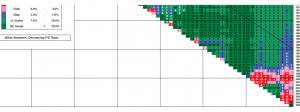Price to Earnings Ratios do predict future market returns to some degree. The problem is sometimes secular trends and P/E expansion/contraction end up playing a stronger role than comparison to historical P/Es alone. So, let’s take a look at these various concepts and see where we’re at now in this week’s MBA Monday at Darwin’s (click for all topics):
Price to Earnings Ratio Defined
The Price to Earnings ratio (P/E) is a very common measure for publicly traded equities whereby you divide the share price by the earnings (new profit) during a given period. In some cases, analysts and investors are looking at “trailing P/Es” which might be the prior year or quarter, or they look at the “forward P/E” which would project the current price over anticipated earnings. That method is obviously prone to error given the divergence of future earnings forecasts for any given stock. When looking at the US market as a whole, it’s commonplace to look at the P/E ratio of the S&P500 (SPY) as an indicator of the market at large. Typically, the US market trades between a range of 10 and the low 20s. Remember the dot-com bubble crash? P/E ratios were more than double that, peaking at about 45. And we all know how that ended.
Price to Earnings Ratio Relevance
A lot of times, you’ll hear Cramer or some analyst touting the “value” of a particular stock because it has a low P/E ratio or that it’s expensive with a very high P/E. If you’re a proponent of efficient market theory, none of that matters for individual equities, as the market has already priced that in. What makes a simple P/E somewhat irrelevant for individual stocks is that they’re all growing at different rates. So, I’d love to have paid a 25 P/E for Apple or Google earlier this decade, but paying a 20 P/E for a utility stock? Ripoff. That’s where the PEG ratio comes in which incorporates growth rate as well (subject of another post). However, for the market at large, earnings and growth rates are a bit more predictable and errors are more easily canceled across hundreds of stocks.
P/E Expansion and Contraction a More Important Indicator?
I came across a really incredible tool provided by Crestmont Research. Essentially, by looking at decades of history to see how stocks have performed into the future based on various P/Es in time, there’s a very clear pattern that develops. The lower the P/E, the better the future returns on stocks and vice-versa. Now, this concept isn’t rocket science at face value. But by analyzing the actual data and comparing where we are now versus how this has panned out virtually every other time in history, it looks highly likely that from here, we will have either a negative or just marginal returns in the stock market for years to come. See, while it may appear that stock market returns are random in any given year, there is undoubtedly very consistent performance across long periods of time (10 years or more) that is very predictable based on starting P/E ratios. Here’s a quick snapshot of the data, but check out for yourself; it’s intuitive after looking at it for a while – especially the legend description:
Based on decades of history and numerous consistently executed pattens, we are heading off a cliff in terms of equities returns. The chart closes with 2010 at a 21 P/E and it’s showing as an incredibly expensive 24 P/E today (Multpl.com). When you look out at the 10 year, and even the 20 year annualized returns following a period of 20 P/Es and higher, it’s quite ugly. Usually, a good time to invest was when P/Es were in the teens or lower. The only thing that would change the outcome here would be a sudden P/E expansion, which doesn’t seem logical given the recent shock to the retail investor and an aging demographic that pushes seniors into less risky assets, not high risk assets. Add to that the value destruction in home equity and a lousy jobs picture and it’s tough to envision a scenario whereby P/Es actually undergo expansion rather than contraction. Unfortunately, the alternatives aren’t great. It’s tough to find safe high yield investments thanks to the Fed, gold and silverETFs be in a bubble, and it’s tough to find non-correlated assets since the world is getting smaller (which we learned all too well during the 2008-2009 crash).
Do P/Es Matter in the End? What are Your Thoughts?



{ 9 comments… read them below or add one }
Hell yes P/E matters. I predicted the US to see PE ratios get up to 27 during 2011, which I believe is the highest we will see for the next 10 to 20 years. All of the stocks I own are low P/E, high dividend yield stocks for this reason – these are the only ones that will profit during this time.
http://www.smallbizbigdreams.com/econ-politics-taxes/economic-financial-predictions-for-2011/
Yes, P/E definitely matters. 24 is pretty high, but all the consumers are in saving mode for the last few years. The Earning is going to expand quite a bit in the next few years.
I’m moving some of my portfolio into rental property to be more diversified though. 🙂
I agree with you that the US market is very expensive. Price/Earnings is an important ratio but I actually like cash flow better since it leaves out accounting gimmicks. More investors need to look at long term valuations and not gamble with short term trading.
Value Investing requires being willing to wait for favorable opportunities. Thank you for the thought provoking article.
http://blog.arborinvestmentplanner.com/2011/03/best-investment-management-system-value-asset-allocation-investing
Price/Earnings ratio definitely holds some value…but I agree cash flow is important, especially for established blue chip stocks. You can’t forget about EBIT/EBITDA. EBITDA is probably one of the most common and important metrics tracked WITHIN any company, so naturally anyone from the outside would be wise to track this as well. Unforunately, in the end, it all comes to investor speculation. I hold GM stock, and they post their biggest profit since 2004, they wiped tons of debt off the balance sheet (through bankruptcy and paying it down), they have shedded significant amounts of money owed to the treasury, purchased another finance arm, and even kept their employee profit sharing checks to a reasonable minimum…Im not saying they didnt have their issues prior, but since the IPO they have been all the right moves…so why the decrease? oh who knows… unrest in one country to the next, investor jitters…stupid speculation! lol sorry this always bothers me.
http://www.moneyistheroot.com
I think high PEs reflect greater on the cost of money than the future of the markets. Sustained low interest rates could keep these PEs, while reasonable growth could easily price out any low-cost of carry premiums.
Good article, Darwin. Considering P/E as one of the metrics keeps emotions in check. There is no “this time it’s different” in this “new economy”.
Absolutely, P/E Matters. It’s interesting to me how many folks think that the markets are headed north for an extended period of time, because stocks do look expensive to me. One has to take a holistic view of things, and none of us are true experts here (at least not me), but I suspect that the market is a bit overbought right now.
The issue is as you put it – what are the clear alternatives? There are warts on each investment vehicle at this point. Yields are low, gold is at highs, and housing hasn’t rebounded despite super low interest rates. It’s an interesting time right now for investors.
The trick is – do you get out of stocks because you fear the secular downtrend? If you did 2 years ago, you missed a huge move up. I guess it’s the lesser of two evils. Wait out the volatility and stay in stocks for decades – or if you need the cash within a few years, pay attention to starting P/Es!
I’m certainly in the camp the market isn’t cheap. As others have mentioned this makes it more important to pick individual stocks and also dividends. I’m not seeing much of anything cheap these days.
With a high P/E we are anticipating high in the future. As investors we are basically buying into a rosy future.
It’s funny you bring this up as the WSJ this past weekend about Shiller vs. Bianco.
http://online.wsj.com/article/SB10001424052748704630004576248991330789506.html?KEYWORDS=shiller
I’m more in the camp of Shiller. While Shiller does not state PE10 is a predictor of future performance or when to get in or out of the market it definitely has some indication.
Though the market can stay irrational longer than you can stay solvent. Look at the 90’s and the high PE then.
So what could happen next to revert back to the mean:
– No or little gains for the next 10 years
– 30% correction in say a month.
– or a slow leak over a few years.
Which would you rather have? I would rather take the 30% since I’m still (somewhat young at 40).
{ 3 trackbacks }